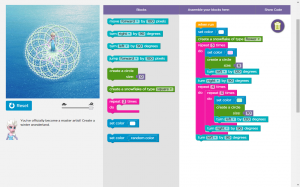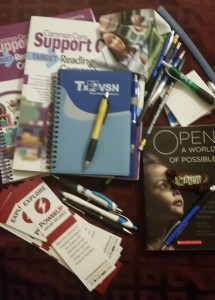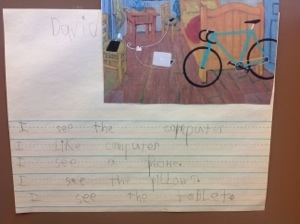February 24, 2015
I’ve just finished #ASTE15, the annual conference for the Alaska Society for Technology in Education. One of the best parts? Hearing Vicki Davis, aka CoolCatTeacher, speak about teaching in the 21st century inspired me. One thing she says is to “innovate like a turtle” as to not take too much on, but always have your “next three” ready to go so you are always moving forward.
My next three:
1. Add more accountability to Genius Hour through rubrics, organizers, and planners.
2. Mystery Skype with another Alaskan classroom.
3. Start blogging for real.
I have more #ASTE15 thoughts, of course, and will kick a new blog off with those ideas. Education is wide open right now, yet pressed in on every side. It’s time to add to that conversation.
 No Comments » |
No Comments » |  aste15, edchat |
aste15, edchat |  Permalink
Permalink
 Posted by Mrs. Stading
Posted by Mrs. Stading
December 11, 2014
I’m feeling a little sneaky using Hour of Code this week: do my students know they are building logic skills? Do they know they are in a competency-based learning environment? Do they have the rush of adrenaline when they finally get it right at the end? I’m sure I do.
Hour of Code is part of a week to promote computer science in schools. The premise is to get students programming. Why programming? I’m going to stick with the logic of it. IF…THEN from my BASIC days. Or maybe that was FORTRAN. I learned both in high school. Do remember them? No, not really. In fact, there’s a third language we had a class for and I don’t remember. COBALT? C++? Regardless, it was a hands-on class with immediate results: if it worked, it worked. If it didn’t, you figured it out.
This is a skill all of our students need: figuring out why something doesn’t work. Asking questions, trying again and again and again…not giving up, not surrendering to the idea that failure is a bad thing. (It is, but only if you stop there.)
Here’s my Hour+ of Code product. I love learning alongside my students.

My creation. I worked for it!
 No Comments » |
No Comments » |  edchat, Elementary, Middle School, STEMchat |
edchat, Elementary, Middle School, STEMchat |  Permalink
Permalink
 Posted by Mrs. Stading
Posted by Mrs. Stading
November 24, 2014

Chat with a vendor, get stuff. There’s no shame in free!
I’m like the world’s least timely blogger meaning if I have good idea to blog about, it will take me weeks to actually sit and write and of course, who cares anymore? Two weeks ago I returned from the iNACOL Symposium for Online and Blended Learning; this post is part of a reflection I’m sending to a couple of people as part of the KPBSD Blended Learning cohort as well as a university for a CEU.
The thing is, these thoughts are timeless. I could post this any time of the year, I bet. Thankfully, people are asking these questions all the time; at some point, we’ll get to ask new questions.
——
The most significant session I attended, though, was not on the schedule. By Wednesday, the Twitter backchannel asked, why are we attending a blended learning conference that doesn’t use blended learning? Why are we always subjected to sit-and-get at conferences where we are being told specifically, do not teach children this way? Through this lament, the iNACOL Edcamp formed, an “unconference” session of fifteen connected educators (because the session was coordinated solely through Twitter or word of mouth) gathered to discuss the unspoken, underlying themes of the conference: are we truly at a point of individualizing learning for students? Why do we hear the same rally call from keynote speakers about individualizing education yet no one addresses the lack of a solid virtual pedagogy that engages the learner beyond rote learning? Are the innovations of private and charter schools truly sustainable in the public school setting? How do we change teacher professional development to professional learning, both for pre-service and currently employed teachers?
These are questions that should resonate with every educator (though only a few of us in the group were actually classroom teachers, and indeed, it seemed that brick-and-mortar teachers were a minority at the conference) and with every instructional decision in the classroom. So I bring away from the conference a reconnection to the ideal of individualized learning; I teach special education, I know what this means. But now, it is my charge to figure how to do this in my classroom and with my students through thoughtful use of technology and teaching, to be more than just a technology-rich classroom but one that draws from all over the globe to transform students into learners.
 No Comments » |
No Comments » |  blended, Web 2.0 |
blended, Web 2.0 |  Permalink
Permalink
 Posted by Mrs. Stading
Posted by Mrs. Stading
November 6, 2014
I’m part of a cohort of teachers from the district who are learning more about blended learning with the intent of building the district’s capacity with this educational model. Blended learning is instruction both face-to-face and independently online. What I am finding, though, is that plenty of people toss it around, emulating the model as ridiculously important when really, blended learning might be more of a theory of practice, a reason to use the approach in the classroom.
The idea behind blended learning is partially to use technology to individualize and personalize learning for students. However, if you don’t have it in your head that learning should look like this, that you don’t have the time to even attempt and make sure students get what they need to be learners, then you probably aren’t even ready to start the discussion and should go back to your happy world of one-size-fits-as-many-as-it-will.
What do I take away from this conference? I’m going to focus less on the logistics of blended learning…giving students control of path, pace, and place (or whatever that catch phrase is)…and get back to the individualzed learning bit.
Why am I going to start the blended learning model in one of my classes come January? Because school isn’t about me covering standards with little regard to the students in my classroom. School is about a class full of learners and because I am not the end-all of knowledge, I need help helping them learn. That’s why I’ll be blending my classroom.
 No Comments » |
No Comments » |  Uncategorized |
Uncategorized |  Permalink
Permalink
 Posted by Mrs. Stading
Posted by Mrs. Stading
October 7, 2014
I’m enthralled by the Global Read Aloud. Tens of thousands of teachers, hundreds of thousands of students, all reading the same book at the same time. All around the world, and then connecting about it. This example of how technology expands the classroom should be extended to all sorts of content. But there’s something about the reading aloud bit that takes this technological masterpiece and turns it into magic that’s not the same as a world-wide Skype session with a scientist. And I think that is a good thing.
You can still join in! www.globalreadaloud.com
 No Comments » |
No Comments » |  edchat, elementary reading, Middle School |
edchat, elementary reading, Middle School |  Permalink
Permalink
 Posted by Mrs. Stading
Posted by Mrs. Stading
September 15, 2014
It has …
Characters…people or aliens or animals
Setting…which is where it is and the time
“Once upon a time”
Main characters
Plot…what’s in the story that happens…a problem and solution (conflict and resolution)
Drama, emotions
A mean person…villain
A nice person…hero, smarty pants
Romance or action or comedy
 No Comments » |
No Comments » |  elemchat, Elementary LA |
elemchat, Elementary LA |  Permalink
Permalink
 Posted by Mrs. Stading
Posted by Mrs. Stading
June 23, 2014
I’m getting a lot of text notifications from Edmodo these days regarding this year’s Global Read Aloud. I’m so excited and it isn’t even until October! I am going to read The Miraculous Journey of Edward Tulane with my elementary group and hope to read The Fourteenth Goldfish with my middle school reading class. Right now, we are working at making connections with other classrooms to share the book. Interested? Intrigued? I’d love to help you get involved with this project!
http://www.globalreadaloud.com/
 No Comments » |
No Comments » |  5thchat, elemchat, elementary reading, GRA14 |
5thchat, elemchat, elementary reading, GRA14 |  Permalink
Permalink
 Posted by Mrs. Stading
Posted by Mrs. Stading



 Posted by Mrs. Stading
Posted by Mrs. Stading





